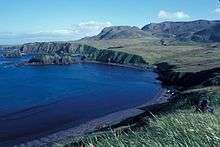Hawadax Island

Hawadax Island (Aleut: Hawadax[1]) is an island in the Rat Islands archipelago of the western Aleutian Islands in the US state of Alaska. The island was formerly known as Rat Island until May 2012 when it was renamed Hawadax Island, which is an Aleut name meaning "entry" and "welcome".[2] The island has a land area of 10.3126 sq mi (26.7095 km²) and no permanent population. It is within the Alaska Maritime National Wildlife Refuge. It is 9.3 miles (15 km) in length and 3.1 miles (5 km) in width.
The former name is the English translation of the name given to the islands by Captain Fyodor Petrovich Litke in 1827 when he visited the Aleutian Islands on a voyage around the world.
The Rat Islands are very earthquake-prone as they are on the boundary of the Pacific and North American tectonic plates. In 1965, there was a major earthquake with the magnitude 8.7 in the Rat Islands.
Restoration

The island was heavily infested with brown rats (Rattus norvegicus), which are considered a nuisance invasive species due to their negative impact on the population of ground-nesting wild birds.[3]
The rats arrived on the island before 1780 due to a Japanese shipwreck.[4] Since then, the rats had a devastating effect on local seabirds that have no natural defenses against the rats.[5] Invasive rats are also present on 16 other islands in the Aleutian chain.[4]
In 2007, the US Fish and Wildlife Service (FWS), which manages the refuge, was formulating plans to eradicate the rats, without negatively affecting other species. Scientists considered the island a test case for other eradications in less isolated environments.[5] The eradication plan is modelled on a successful one to eliminate the Arctic fox from various Aleutian islands, where they were deliberately introduced for breeding.[4]
In June 2009, the island was declared rat-free for the first time in 229 years, although the site will be continually monitored for another two years for confirmation. In the preceding autumn, helicopters dropped brodifacoum poison onto the island from buckets for a week, which eliminated the rat population. Signs show that several species of birds, including Aleutian cackling geese, ptarmigan, peregrine falcons, and black oystercatchers, are starting to nest again on the island.[6] However, the associated nontarget mortality, i.e., the deaths of animals other than the rats, was significant.[7] Some non-target mortality was expected, but the actual quantity greatly exceeded what was predicted.[7] The Ornithological Council reported that more than 420 birds were killed as a result of the rat eradication program.[7] Forty-six bald eagles died (exceeding the known population of 22 bald eagles on the island); toxicological analysis revealed lethal levels of brodifacoum in 12 of the 16 carcasses tested. Of the 320 glaucous-winged gull carcasses collected, toxicology tests implicated brodifacoum in 24 of the 34 tested. Fifty-four carcasses of another 25 bird species were found.[8][9] The report found that the lead contractor which the FWS used, Island Conservation, had dropped more poisonous bait than they had proposed, including bait which was intended to be saved as a backup.[7] The FWS asked the Ornithological Council to determine if Island Conservation had exceeded the limit of their poison quantities, but the council decided not to resolve any "legal questions".[7] As of 2011, FWS law enforcement is still investigating.[7] Steve Delehanty, the manager of the Alaska Maritime National Wildlife Refuge (which includes the island) said that, "It was a learning experience, and we made mistakes together."[7] However, he also stated, "...if you do the math this was a rip-roaring conservation success."[7]
See also
- Campbell Island, New Zealand, the largest successful rat eradication.
References
- ↑ Bergsland, K. (1994). Aleut Dictionary. Fairbanks: Alaska Native Language Center.
- ↑ "Feature Detail Report for: Hawadax Island". US Geological Survey Board on Geographic Names. Retrieved 31 May 2012.
- ↑ Rats wipe out seabirds on Alaska island
- 1 2 3 Ebbert, S.E.; Byrd, G.V. (2002). "Eradications of invasive species to restore natural biological diversity on Alaska Maritime National Wildlife Refuge". In Veitch, C.R. Turning the Tide: The Eradication of Invasive Species : Proceedings of the International Conference on the Eradication of Island Invasives. The World Conservation Union. ISBN 2-8317-0682-3. Retrieved 2007-10-03.
- 1 2 "Biologists aim to wipe out Rat Island". Reuters. October 2, 2007. Retrieved 2007-10-02.
- ↑ Alaska's Rat Island rat-free after 229 years
- 1 2 3 4 5 6 7 8 Borrell, Brendan (18 January 2011). "Where eagles die". Nature. doi:10.1038/news.2011.24.
- ↑ Steve Ebbert and Kathy Burek-Huntington. 2010. Anticoagulant Residual Concentration and Poisoning in Birds Following a Large-Scale Aerial Application of 25 ppm Brodifacoum Bait for Rat Eradication on Rat Island, Alaska. Proceedings of the 24th Vertebrate Pest Conference (R. M. Timm and K. A. Fagerstone,Eds.). Published at Univ. of Calif., Davis.
- ↑ THE RAT ISLAND RAT ERADICATION PROJECT: A CRITICAL EVALUATION OF NONTARGET MORTALITY. PREPARED FOR ISLAND CONSERVATION, THE NATURE CONSERVANCY and the U.S. FISH AND WILDLIFE SERVICE, ALASKA MARITIME NATIONAL WILDLIFE REFUGE. PREPARED BY THE ORNITHOLOGICAL COUNCIL. Final report issued December 2010
External links
- Rat Island Invasive Rat Eradication Project Environmental Assessment
- Rat Island: Block 1140, Census Tract 1, Aleutians West Census Area, Alaska United States Census Bureau
Coordinates: 51°48′09″N 178°17′51″E / 51.80250°N 178.29750°E